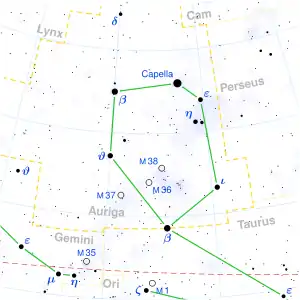Beta Aurigae
Beta Aurigae (Latinized from β Aurigae, abbreviated Beta Aur, β Aur), officially named Menkalinan /mɛŋˈkælɪnæn/,[10][11] is a binary star[12] system in the northern constellation of Auriga. The combined apparent visual magnitude of the system is 1.9,[2] making it the second-brightest member of the constellation after Capella. Using the parallax measurements made during the Hipparcos mission, the distance to this star system can be estimated as 81.1 light-years (24.9 parsecs), give or take a half-light-year margin of error.[1]
 | |
| Observation data Epoch J2000.0 Equinox J2000.0 | |
|---|---|
| Constellation | Auriga |
| Right ascension | 05h 59m 31.72293s[1] |
| Declination | +44° 56′ 50.7573″[1] |
| Apparent magnitude (V) | +1.90[2] |
| Characteristics | |
| Spectral type | A1m IV + A1m IV[3] |
| U−B color index | +0.05[2] |
| B−V color index | +0.03[2] |
| R−I color index | –0.01 |
| Variable type | Algol variable |
| Astrometry | |
| Radial velocity (Rv) | –18.2[4] km/s |
| Proper motion (μ) | RA: –56.44[1] mas/yr Dec.: –0.95[1] mas/yr |
| Parallax (π) | 40.21 ± 0.23[1] mas |
| Distance | 81.1 ± 0.5 ly (24.9 ± 0.1 pc) |
| Absolute magnitude (MV) | 0.55/0.76[5] |
| Orbit[6] | |
| Period (P) | 3.96004 days |
| Eccentricity (e) | 0.0 |
| Inclination (i) | 76.0 ± 0.4° |
| Periastron epoch (T) | 54539.0162 ± 0.0003 reduced HJD |
| Semi-amplitude (K1) (primary) | 108.053 ± 0.072 km/s |
| Semi-amplitude (K2) (secondary) | 110.911 ± 0.071 km/s |
| Details | |
| β Aur A | |
| Mass | 2.389 ± 0.013[6] M☉ |
| Radius | 2.77[7] R☉ |
| Luminosity | 48[8] L☉ |
| Surface gravity (log g) | 3.93[5] cgs |
| Temperature | 9,350[7] K |
| Rotational velocity (v sin i) | 33[7] km/s |
| Age | 570[7] Myr |
| β Aur B | |
| Mass | 2.327 ± 0.013[6] M☉ |
| Radius | 2.63[7] R☉ |
| Luminosity | 48[8] L☉ |
| Temperature | 9,200[7] K |
| Rotational velocity (v sin i) | 34[7] km/s |
| Other designations | |
| Database references | |
| SIMBAD | data |
Nomenclature
β Aurigae is the star system's Bayer designation. The traditional name Menkalinan is derived from the Arabic منكب ذي العنان mankib ðī-l-‘inān "shoulder of the rein-holder". In 2016, the International Astronomical Union organized a Working Group on Star Names (WGSN)[13] to catalog and standardize proper names for stars. The WGSN's first bulletin of July 2016[14] included a table of the first two batches of names approved by the WGSN; which included Menkalinan for this star.
It is known as 五車三 (the Third Star of the Five Chariots) in traditional Chinese astronomy.
Properties

Beta Aurigae is a binary star system, but it appears as a single star in the night sky. The two stars are metallic-lined subgiant stars belonging to the A-type stellar classification;[3] they have roughly the same mass and radius. A-type entities are hot stars that release a blue-white hued light; these two stars burn brighter and with more heat than the Sun, which is a G2-type main sequence star. The pair constitute an eclipsing spectroscopic binary; the combined apparent magnitude varies over a period of 3.96 days between +1.89 and +1.94, as every 47.5 hours one of the stars partially eclipses the other from Earth's perspective.[15]
At an angular separation of 13.9 ± 0.3 arcseconds along a position angle of 155° is a companion star that is 8.5 magnitudes fainter than the binary pair. This is a candidate member of Beta Aurigae, which would make it a triple star system. It may be the source of the X-ray emission from the vicinity.[16] The Beta Aurigae system is believed to be a stream member of the Ursa Major Moving Group.[17]
See also
References
- van Leeuwen, F. (November 2007), "Validation of the new Hipparcos reduction", Astronomy and Astrophysics, 474 (2): 653–664, arXiv:0708.1752, Bibcode:2007A&A...474..653V, doi:10.1051/0004-6361:20078357, S2CID 18759600
- Johnson, H. L.; et al. (1966), "UBVRIJKL photometry of the bright stars", Communications of the Lunar and Planetary Laboratory, 4 (99): 99, Bibcode:1966CoLPL...4...99J
- Southworth, J.; Bruntt, H.; Buzasi, D. L. (June 2007), "Eclipsing binaries observed with the WIRE satellite. II. β Aurigae and non-linear limb darkening in light curves", Astronomy and Astrophysics, 467 (3): 1215–1226, arXiv:astro-ph/0703634, Bibcode:2007A&A...467.1215S, doi:10.1051/0004-6361:20077184, S2CID 16446042.
- Wilson, R. E. (1953), "General Catalogue of Stellar Radial Velocities", Washington, Carnegie Institute of Washington D.C., Bibcode:1953GCRV..C......0W
- Torres, G.; Andersen, J.; Giménez, A. (February 2010), "Accurate masses and radii of normal stars: modern results and applications", The Astronomy and Astrophysics Review, 18 (1–2): 67–126, arXiv:0908.2624, Bibcode:2010A&ARv..18...67T, doi:10.1007/s00159-009-0025-1, S2CID 14006009
- Behr, Bradford B.; et al. (July 2011), "Stellar Astrophysics with a Dispersed Fourier Transform Spectrograph. II. Orbits of Double-lined Spectroscopic Binaries", The Astronomical Journal, 142 (1): 6, arXiv:1104.1447, Bibcode:2011AJ....142....6B, doi:10.1088/0004-6256/142/1/6, S2CID 119099887
- Nordstrom, B.; Johansen, K. T. (1994), "Radii and masses for beta Aurigae", Astronomy and Astrophysics, 291 (3): 777–785, Bibcode:1994A&A...291..777N
- Kaler, James B., "MENKALINAN (Beta Aurigae)", Stars, University of Illinois, retrieved 2010-01-23
- "bet Aur". SIMBAD. Centre de données astronomiques de Strasbourg. Retrieved 2012-07-18.
- Kunitzsch, Paul; Smart, Tim (2006). A Dictionary of Modern star Names: A Short Guide to 254 Star Names and Their Derivations (2nd rev. ed.). Cambridge, Massachusetts: Sky Pub. ISBN 978-1-931559-44-7.
- "IAU Catalog of Star Names". Retrieved 28 July 2016.
- Eggleton, P. P.; Tokovinin, A. A. (September 2008), "A catalogue of multiplicity among bright stellar systems", Monthly Notices of the Royal Astronomical Society, 389 (2): 869–879, arXiv:0806.2878, Bibcode:2008MNRAS.389..869E, doi:10.1111/j.1365-2966.2008.13596.x, S2CID 14878976.
- "IAU Working Group on Star Names (WGSN)". Retrieved 22 May 2016.
- "Bulletin of the IAU Working Group on Star Names, No. 1" (PDF). Retrieved 28 July 2016.
- Malkov, O. Yu.; Oblak, E.; Snegireva, E. A.; Torra, J. (February 2006), "A catalogue of eclipsing variables", Astronomy and Astrophysics, 446 (2): 785–789, Bibcode:2006A&A...446..785M, doi:10.1051/0004-6361:20053137.
- De Rosa, R. J.; et al. (July 2011), "The Volume-limited A-Star (VAST) survey - I. Companions and the unexpected X-ray detection of B6-A7 stars", Monthly Notices of the Royal Astronomical Society, 415 (1): 854–866, arXiv:1103.4363, Bibcode:2011MNRAS.415..854D, doi:10.1111/j.1365-2966.2011.18765.x, S2CID 84181878
- Giannuzzi, M. A. (August 1979), "On the eclipsing binaries of the Ursa Major stream", Astronomy and Astrophysics, 77 (1–2): 214–222, Bibcode:1979A&A....77..214G.